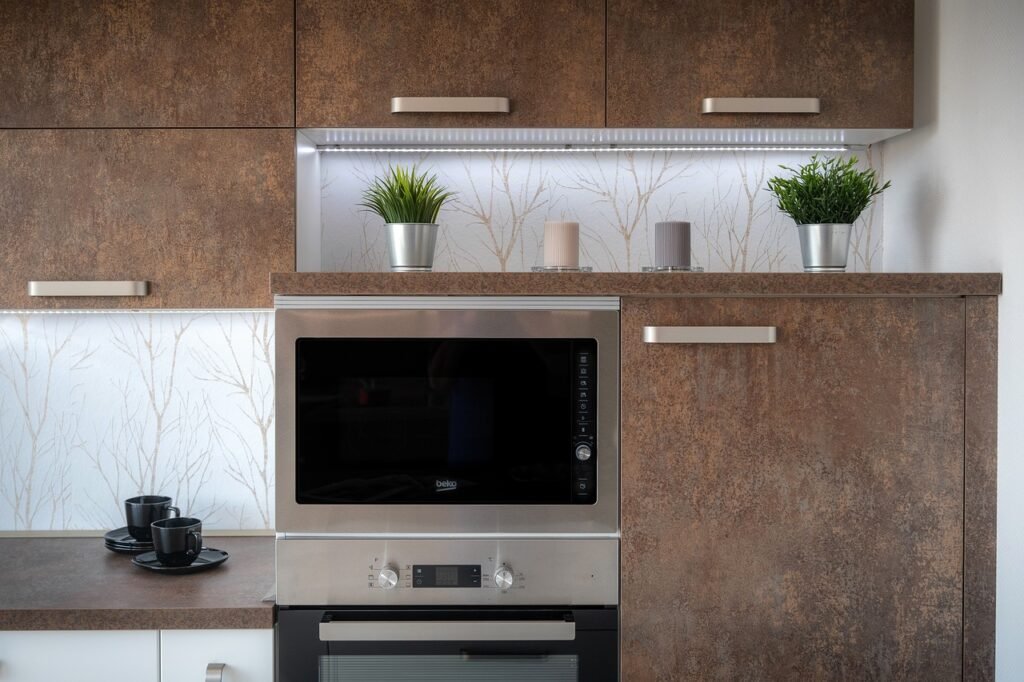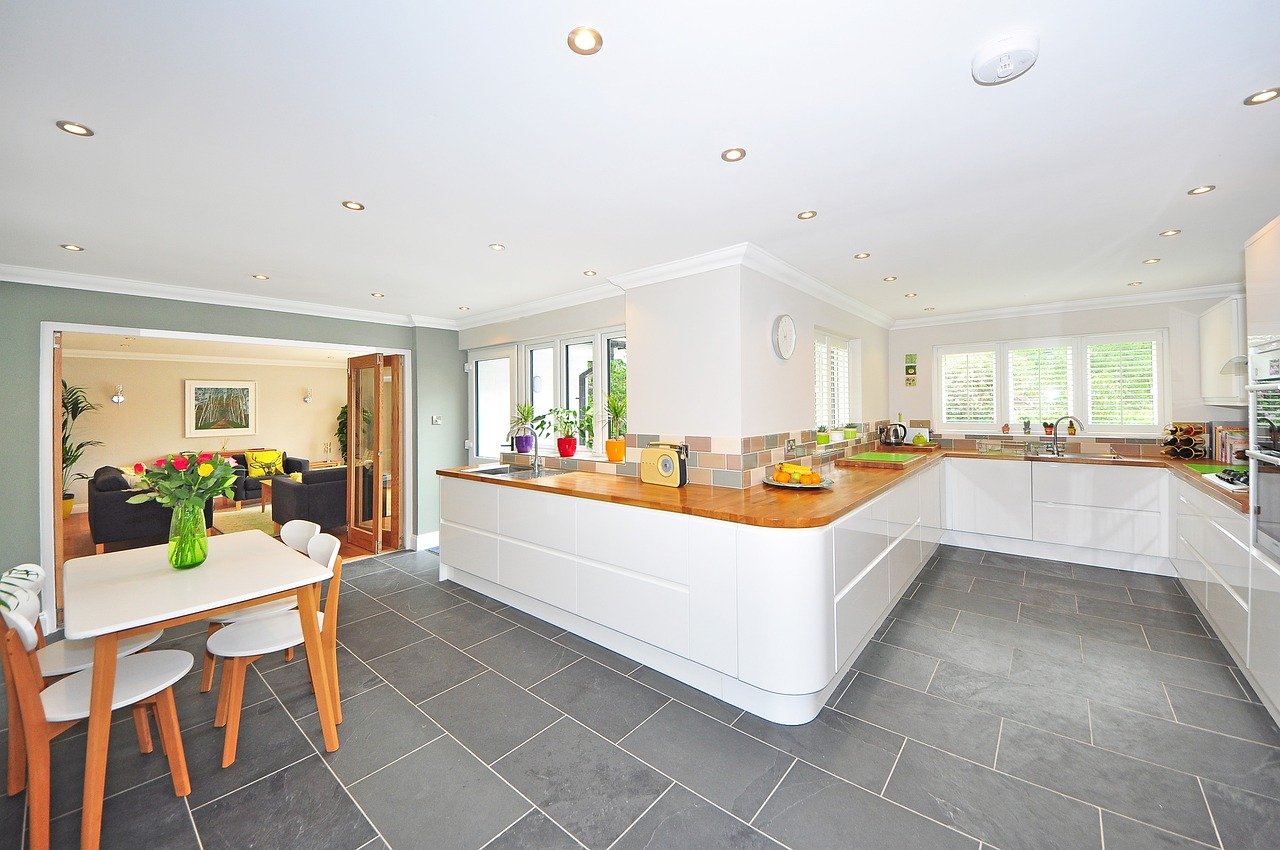Imagine stepping into your kitchen and being greeted by a warm and inviting atmosphere. The trick? Layered lighting. By strategically incorporating multiple light sources in your kitchen, you can transform it into a beautifully lit space that not only enhances functionality but also creates a cozy ambiance. Whether it’s task lighting for meal preparation, accent lighting to highlight specific features, or ambient lighting for overall illumination, the possibilities are endless. Say goodbye to dull and drab kitchens, and say hello to a space that radiates both style and warmth.
Understanding Layered Lighting
Definition and Purpose
Layered lighting refers to the strategic use of multiple light sources, placed at different heights and angles, to create a well-lit and visually appealing space. The purpose of layered lighting is to provide both functional illumination and enhance the overall ambiance of a room. In the kitchen, where various activities take place, such as cooking, dining, and socializing, layered lighting can be particularly beneficial in creating a beautiful and functional space.
Benefits of Layered Lighting in the Kitchen
Layered lighting offers numerous benefits in the kitchen. Firstly, it allows you to customize the lighting according to your needs and create specific zones for different activities. For example, you can have brighter task lighting over the countertop for food preparation and a softer ambiance for dining areas. Additionally, layered lighting can highlight the architectural features, decor, and focal points in your kitchen, enhancing its visual appeal. By properly illuminating your workspace, layered lighting can also improve safety and efficiency while performing tasks in the kitchen.
Determining Lighting Zones
General or Ambient Lighting
General or ambient lighting serves as the overall illumination for a space, providing a comfortable level of brightness to navigate and perform basic tasks. In the kitchen, this lighting can be achieved through the use of ceiling-mounted fixtures, such as recessed lights or surface-mounted fixtures. To create an even distribution of light, it is recommended to space the fixtures uniformly throughout the room, avoiding any dark corners.
Task Lighting
Task lighting is essential for illuminating specific work areas in the kitchen, such as countertops, stovetops, and sinks. It ensures that you have sufficient light to perform tasks with precision and accuracy. Some popular choices for task lighting in the kitchen include under-cabinet lighting, pendant lights, and track lighting. By placing task lighting fixtures strategically, you can eliminate shadows and glare, making your kitchen workspace both functional and comfortable.
Accent or Decorative Lighting
Accent or decorative lighting is used to add visual interest and highlight specific elements in your kitchen, such as artwork, architectural details, or decorative objects. This type of lighting creates a focal point and can be achieved through the use of wall sconces, uplights, or spotlights. By selectively illuminating certain areas or objects, accent lighting adds depth and dimension to your kitchen, creating a warm and inviting atmosphere.
Choosing the Right Fixtures

This image is property of pixabay.com.
Consider the Kitchen Layout
When choosing lighting fixtures for your kitchen, it is important to consider the layout and the specific areas you want to illuminate. The size and shape of your kitchen will help determine the number and placement of fixtures needed. For example, in a larger kitchen, you may need multiple ceiling-mounted fixtures or pendant lights to adequately light the space. In smaller kitchens, recessed lighting or track lighting can be a space-saving option.
Types of Lighting Fixtures to Use
There is a wide variety of lighting fixtures available, each serving a different purpose. As mentioned earlier, ceiling-mounted fixtures like recessed lights and surface-mounted fixtures provide general illumination. Under-cabinet lighting is ideal for task lighting, as it illuminates specific work areas. Pendant lights and chandeliers can add a touch of elegance and serve as both functional and decorative lighting. Consider mixing and matching different types of fixtures to achieve the desired layered lighting effect.
Matching Fixture Styles with Kitchen Design
In addition to considering functionality, it is crucial to select lighting fixtures that complement the overall design and style of your kitchen. Whether your kitchen has a modern, traditional, or eclectic design, there are fixtures available in various styles, finishes, and materials to match your aesthetic. By coordinating the style and finish of your lighting fixtures with the existing elements in your kitchen, such as cabinet hardware or faucets, you can achieve a cohesive and harmonious look.
Placement and Installation
Layering Lights at Different Heights
To create a visually appealing and well-balanced lighting scheme, it is essential to place lights at different heights. This adds depth and dimension to your kitchen, avoiding a flat and dull lighting effect. For example, you can combine overhead pendant lights with under-cabinet lighting or wall sconces. By varying the height of the light sources, you create an interesting interplay of light and shadows, enhancing the overall ambiance of your kitchen.
Ideal Locations for Task Lighting
Task lighting should be strategically placed in areas where specific work takes place. Over the countertop or island, for example, it is crucial to have adequate lighting for food preparation and cooking. Installing under-cabinet lighting directly above these work areas ensures that you have ample illumination without casting disruptive shadows. Similarly, lighting above the stove and sink will make these tasks safer and more efficient, reducing the risk of accidents.

This image is property of pixabay.com.
Accent Lighting Placement Tips
When it comes to accent lighting, the placement will depend on the elements you want to highlight. Wall sconces can be installed near artwork, while uplights can be positioned to graze textured walls or architectural features. Spotlights are ideal for drawing attention to specific objects or collectibles, such as china cabinets or open shelves. Experiment with different placements to find the most flattering angles and achieve the desired visual impact.
Selecting Bulbs and Color Temperature
Types of Bulbs for Various Lighting Functions
The choice of bulbs can greatly influence the overall look and feel of your kitchen lighting. Some popular options include incandescent, halogen, fluorescent, and LED bulbs. Incandescent bulbs provide a warm and inviting glow, while halogen bulbs offer a whiter and brighter light. Fluorescent bulbs are energy-efficient and provide even illumination, making them suitable for general lighting. Lastly, LED bulbs are highly energy-efficient, long-lasting, and come in a range of color temperatures.
Understanding Color Temperature
Color temperature refers to the hue or warmth of the light emitted by a bulb and is measured in Kelvin. Lower Kelvin temperatures, around 2700-3000K, produce a warm and cozy light similar to incandescent bulbs. Higher Kelvin temperatures, such as 4000-5000K, provide a cooler, more daylight-like light. When selecting bulbs for your kitchen, consider the mood and functionality you want to achieve. Warm light is often preferred for dining areas or when creating a cozy atmosphere, while cooler light is suitable for task-oriented areas.
Creating the Right Ambiance with Color Temperature
By carefully selecting bulbs with the appropriate color temperature, you can create the desired ambiance in your kitchen. For example, warm light with a lower Kelvin temperature can make your kitchen feel cozy and inviting, ideal for socializing or dining. Cooler light, on the other hand, can enhance focus and alertness, making it ideal for task areas where precision is required. By combining different color temperatures within your layered lighting scheme, you can achieve a dynamic and versatile lighting setup.
Utilizing Natural Light
Maximizing Natural Light Sources
Natural light is a valuable resource that can enhance the beauty and functionality of your kitchen. Make the most of existing windows and skylights by keeping them clean and free from obstructive elements. Position your kitchen workspace, such as the countertop or sink, near natural light sources to benefit from the ample illumination. Orienting your kitchen layout to take advantage of the natural light can reduce the need for artificial lighting during the day, saving energy and adding a pleasant touch to your space.

This image is property of pixabay.com.
Window Treatments for Diffusing or Filtering Light
While natural light is desirable, there may be instances when you want to control the amount or intensity of sunlight entering your kitchen. Window treatments, such as blinds, curtains, or shades, can be utilized to diffuse or filter the light. Sheer curtains, for example, allow diffused light through while providing privacy. Roller blinds or Roman shades can be adjusted to control the amount of light entering the room. Choose window treatments that complement your kitchen design and allow flexibility in adjusting the lighting as needed.
Integrating Smart Lighting Solutions
Introduction to Smart Lighting
Smart lighting refers to a system that allows you to control the lighting in your kitchen through technology. With smart lighting, you can adjust the brightness, color, and even the timing of your lights using a smartphone, voice command, or a central control panel. This innovative lighting solution offers convenience, energy efficiency, and customization options, allowing you to create the perfect lighting ambiance in your kitchen.
Benefits of Smart Lighting in the Kitchen
Smart lighting brings numerous advantages to the kitchen. One of the main benefits is convenience. With smart controls, you can easily dim or turn on/off the lights without having to reach for individual switches. This feature is particularly useful when your hands are occupied with cooking or other tasks. Another advantage is energy efficiency. Smart lighting systems often come with energy-saving features such as motion sensors or timers, ensuring that lights are not left on unnecessarily. Additionally, smart lighting allows for creative lighting scenes, mood settings, and integration with other smart home devices, enhancing the overall functionality and enjoyment of your kitchen.
Popular Smart Lighting Systems and Features
Several popular brands offer smart lighting systems that have gained recognition for their performance and features. Philips Hue, for instance, provides a range of smart bulbs that can be controlled via a smartphone app or voice assistants. They offer customizable color options, scheduling capabilities, and integration with other smart home devices. Another notable brand is Lutron, known for its advanced lighting control systems that allow for personalized scenes, remote access, and energy-saving settings. Explore different brands and their specific features to find a smart lighting system that suits your needs and preferences.
Considerations for Energy Efficiency
LED Lighting for Energy Savings
LED lighting has become the go-to choice for energy-efficient illumination. Compared to traditional incandescent or fluorescent bulbs, LEDs consume significantly less energy and have a longer lifespan. By replacing outdated lighting fixtures with LED alternatives, you can reduce your energy consumption and save on electricity bills. Additionally, LED bulbs produce less heat, contributing to a cooler and more comfortable kitchen environment.
Dimmers and Sensors
Dimmers and sensors are effective tools for optimizing energy usage. By installing dimmers, you can adjust the brightness of your lights according to your needs, preventing unnecessary energy consumption. Motion sensors are useful in areas like pantries or closets, where lights are often left on by mistake. These sensors detect motion and automatically switch the lights on or off, ensuring that lights are only illuminated when needed. Incorporating dimmers and sensors into your layered lighting setup can help you maintain energy efficiency without compromising functionality.
Proper Maintenance and Upkeep
To maximize the efficiency and lifespan of your lighting fixtures, it is important to practice proper maintenance and upkeep. Regularly clean the fixtures and replace any burnt-out bulbs promptly. Keep track of any signs of wear or damage, such as flickering lights or loose connections, and address them promptly. Additionally, consider scheduling professional maintenance checks to ensure that your lighting system is in optimal condition. By taking care of your lighting fixtures, you can extend their lifespan, maintain energy efficiency, and avoid potential safety hazards.
Creating Ambiance through Layered Lighting
Combining Different Lighting Zones
The key to creating ambiance in your kitchen is to combine the different lighting zones effectively. By layering general, task, and accent lighting, you can achieve both functional illumination and a visually appealing atmosphere. For example, you can use recessed lights or pendant lights as your general lighting, while under-cabinet or track lighting serves as task lighting. Enhance the ambiance further by incorporating accent lighting through wall sconces or uplights. By striking a balance between these lighting zones, you can create a versatile and inviting space for various activities in the kitchen.
Using Dimmers and Controls
Adding dimmers and controls to your layered lighting setup allows you to adjust the intensity and mood of your kitchen lighting. By dimming the lights, you can create a soft and cozy ambiance for intimate gatherings or late-night snacks. Brightening the lights, on the other hand, ensures ample illumination for cooking or completing tasks. With advanced control systems, you can even program different lighting scenes for different occasions, such as a bright white light for morning routines or a warm glow for relaxed evenings. This flexibility allows you to adapt your lighting to the specific needs and moods of the moment.
Adding Lighting Accessories for Warmth
In addition to the various fixtures, bulbs, and controls, there are additional accessories that can enhance the warmth and ambiance of your kitchen lighting. Consider incorporating elements such as dimmable rope lights or LED strips under cabinets or along the ceiling to add a subtle and inviting glow. Decorative lampshades or diffusers can soften the light and create a warm and cozy atmosphere. Mirrors or reflective surfaces strategically placed can help bounce light around the kitchen, making the space appear brighter and more inviting. Experiment with different accessories to find the perfect combination that adds warmth and personality to your kitchen.
Final Tips and Recommendations
Seek Professional Advice or Consultation
If you feel overwhelmed or unsure about designing and implementing a layered lighting scheme, it is always beneficial to seek professional advice or consultation. Lighting professionals can assess your specific kitchen layout and design goals, offering valuable insights and recommendations. They can help ensure that lighting fixtures are placed appropriately, taking into consideration factors such as task areas, focal points, and natural light sources. With their expertise, you can achieve an optimal and aesthetically pleasing lighting setup in your kitchen.
Experiment with Lighting Configurations
Creating a layered lighting scheme is a creative process, and it often takes some experimentation to find the perfect configuration. Play around with different combinations of fixtures, bulbs, placements, and controls to achieve your desired effect. Try different intensities and angles of light to see how they interact with your kitchen space. Don’t be afraid to make adjustments and fine-tune as you go along. By experimenting and exploring different options, you can discover unique and personalized lighting solutions that suit your style and preferences.
Regularly Evaluate and Adjust Lighting Setup
Once you have established your layered lighting setup, it is important to regularly evaluate and adjust as needed. Over time, your lighting needs or preferences may change, or the functionality of certain fixtures may diminish. Take the time to assess the effectiveness of your lighting setup and make any necessary adjustments. This may include replacing bulbs, repositioning fixtures, or updating controls. By staying proactive and attentive to your lighting system, you can ensure that it continues to enhance your kitchen’s ambiance and functionality for years to come.
In conclusion, layered lighting is a valuable technique for creating a beautiful ambiance in your kitchen. By strategically incorporating general, task, and accent lighting, you can achieve both functional and visually appealing illumination. Consider the layout and design of your kitchen when selecting lighting fixtures and ensure that they match your style. Place lights at different heights, emphasizing task areas and elements you want to highlight. Choose bulbs and color temperatures that create the desired ambiance. Make the most of natural light sources and consider integrating smart lighting solutions for convenience and energy efficiency. Regular maintenance and adjustments will help maintain optimal performance. By experimenting with configurations and seeking professional advice when needed, you can design a unique and inviting kitchen lighting setup that enhances your overall cooking and dining experience.
